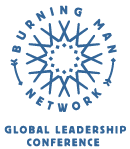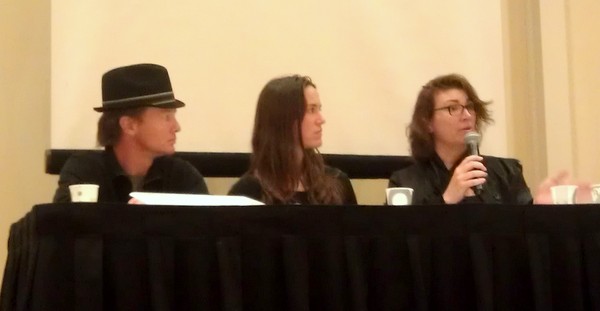If you’re trying to raise money to bring your project to the playa, read this. One of the most well-attended GLC sessions this weekend was the Fundraising Panel: Crowdsourced Fundraising for Art (and Other) Projects with Jess Hobbs, Co-Director of Flux Foundation and Amy Critchett, Executive Director of Illuminate the Arts. Your jaws have likely dropped at the sight of their projects. Last year’s Zoa and 2010’s Temple of Flux are just a few projects that Flux Foundation brought to Black Rock City. Illuminate the Arts’ The Bay Lights, which is the world’s largest LED light sculpture stretching the 1.8 mile length of the Bay Bridge, continues to awe San Franciscans and visitors alike.
Panel host Will Chase challenged both of them to answer, “What are the arrows in your quiver” for effective fundraising? Their arrows include:
Relationships are the most important currency: Amy emphasized that surrounding yourself with a good team, growing forward-facing relationships is key (see above statement from Illuminate the Arts Board Member Christina Harbridge). Being strategic and appropriate about leaning into those relationships for fundraising is also an important skill.
Having essential skills: Artists inspire us with their work, but don’t always dazzle us with their fundraising skills. Besides being ballsy, direct, gregarious, organized and rejection-proof, a good development person must also understand and connect with the project’s vision. In addition to the above traits, Will added that this person must have certain technical capabilities including event planning and social media skills and a deep understanding of the donor community for a project.
Don’t forget to ask: Being transparent and vocal in communicating with potential donors is important, but so is asking for money. It’s easy to talk about an amazing project, but many people are afraid to actually ask for support. Asking means being straight-forward and a little vulnerable. Check out Amanda Palmer’s great TED talk, “The Art of Asking” for reference.
Timing timing timing: Asking too often, too seldom, too early or too late can lead to an embarrassing situation. Raise your hand if you’ve fundraised for a project which you already burned on the playa. You don’t want to be that guy.
Crowdfunding is not a one-size fits all solution: Although many artists use Kickstarter, this crowdfunding platform doesn’t work well for every project. The Bay Lights did not have a huge response from Kickstarter and Jess noted that nowadays the response is not as good as in previous years. Donor fatigue, especially in the Burner community, where seemingly everyone is connected to a project in need of money, can easily set in.
Event plan strategically: Experiences are a great way to grow peer to peer connection, but can also take a huge amount of resources to pull off successfully. Be mindful of your audience and strategic about your resources in organizing events, whether dinner parties, club parties or learning experiences, for specific supporters.
Partner with smart organizations: Not all support takes the form of donations. Consider partnering with groups, which can help pull in more supporters, for joint fundraisers or material donations. Amy added that being clear and careful about a partnership relationship is important. For example, a luxury car company wanted to give 3 million dollars for naming rights to The Bay Lights—something that was never on the table.
The Emotional Hook: Think creatively about how to engage people’s attention and build an emotional connection between them and projects. The Gift of Light campaign is a great example. In order to fill the $2M gap in their fundraising goal, Illuminate the Arts is offering the opportunity to buy a light on the Bay Bridge for themselves or as a gift for a loved one—a creative way to raise funds and engage with potential donors.
Always thank your donors: Thanking your donors shows professionalism, encourages them to share your project with friends and maintain good relationships which you can activate in the future. If you are thanking your donors with stuff, consider low cost objects which will further your cause (i.e. remember to add your logo to that swag!). Experiential rewards are also effective in appealing to default world donors, who are unfamiliar with your kind of art: invite them to your workshop to meet the artists, give welding lessons. Will added that sensitivity regarding these rewards is important—rewarding donors with VIP access to your art car or exclusive “Burning Man” access to etc. is not cool.
I’ve asked all my friends for help, now what?: Panelists and attendees suggested checking out the Foundation Center, which manages a database on primarily US grantmakers, and Start Some Good, which is a crowdfunding platform specifically for social entrepreneurs and non-profits. Both resources can help you realize your fundraising goals.
I hope this recap helps you bring your project to the playa! If you have resources or advice to add on this topic, please share them on our Pathables network.


Leave a Reply